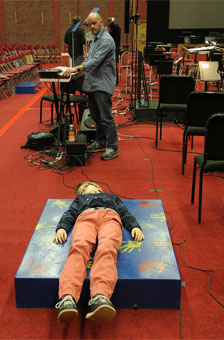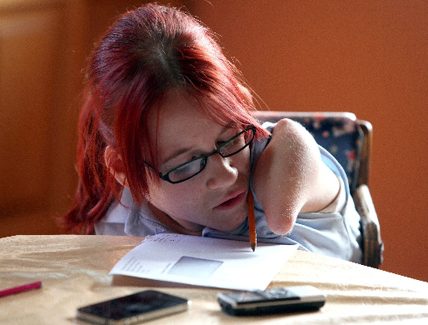In order to see this content you need to have both Javascript enabled and Flash installed. Visit BBC Webwise for full instructions. If you’re reading via RSS, you’ll need to visit the blog to access this content.
The National Orchestra of Wales has been staging unique workshops and concerts for deaf people. Radio 4 reporter Andrew Bomford discovers children listening to music in a very physical way and speaks to those behind it. Here he blogs about his emotional day.
I’ll admit that I am a bit weepy sometimes. I cried at the end of Les Miserables, so the moment that the Welsh National Orchestra string section got started, and Katherine Mount stood there, signing and singing to her profoundly deaf – but clearly enraptured – ten year old son Ethan, I wasn’t surprised to feel myself choking up again.
Watch Katherine Mount singing Ethan’s Song on YouTube
It was towards the end of a long, joyful, but emotionally draining day with the orchestra and children from The Ysgol Maes Dyfan special school in Barry near Cardiff. Some of them are almost completely deaf and others have serious hearing problems, but the joy and enthusiasm shown by the children in their appreciation of the music they were experiencing was wonderful to see.
This was part of an outreach programme by the National Orchestra of Wales which has seen members of the orchestra regularly working with school children on musical improvisations, as well as the simple joy of making music. It was all culminating in a series of five free concerts for schools and the general public, taking part in Cardiff over the last couple of days.
So how does that work then, you might wonder? Music for deaf people? It doesn’t seem to make a lot of sense.
“Music can just affect people – there is an emotional connection,” said Andy Everton, an Outreach Officer for the national orchestra, and himself a trumpet player, “I really don’t think you have to hear it in order to appreciate it. There is an emotional connection which just happens.”
Andy tells a story about going into a school and seeing a severely disabled deaf child who seemed to be incapable of any contact at all with anyone. He stood behind her playing the trumpet (with the sound dampened) and to everyone’s amazement saw her reaction as she moved her eyes to follow the music wherever he went. It was the first time anyone had seen her make any kind of connection to the outside world.
Other children from the school just jumped at the opportunity to simply bang a drum, hold the bass clarinet or the harp as it was played, and to feel the curious sensation of the sound waves moving through their bodies via their sense of touch.
The orchestra has also come up with an ingenious solution to the question of how deaf children can experience music.
They’ve built sound boxes – large wooden platforms, with heavy speakers inside them, which play the music, and are especially effective with the low frequency sounds, in a way that resonates sound through whatever part of the body is in contact with the box.
I saw deaf children sitting on the boxes, touching them with their hands, and even lying fully prone on them, with huge grins on their faces as they felt the vibrations of the music (You can see an explanation of this in the above video). Two deaf boys, Ethan (a different Ethan) and Ashley from Maes Dyfan school stood on the sound boxes and belted out a rap tune they’d improvised with the accompaniment of the orchestra.
“When they use the microphone they can feel their voices from the box and through their feet,” explained Andy Pidcock, a keyboard player who’s done a lot of work with deaf children, “They can feel everything they’re doing and they can feel the beat.” I tried it out myself – it was a fascinating sensation; somewhat similar to the thud of loud bass you can sometimes feel in your chest at a very loud concert.
The orchestra’s work has been championed by the charity Music and the Deaf, run by Paul Whittaker. “This is the only occasion when an orchestra has done a fully integrated project for deaf people,” Paul said, “Normally an orchestra might go into a deaf school or work with a group of deaf children. They might go to a concert where they sit and watch what goes on. Here it’s fully participatory. They come and sit with the orchestra and take part.”
But, as mentioned earlier, the tear-jerker of the night was certainly Katherine Mount’s beautiful performance of “Ethan’s Song”. With a gorgeous show-tune style melody, it was written by Katherine’s friend Helen Goldwyn, who was inspired after watching Ethan experiencing a music concert.
The song asks lots of fundamental questions about what the 10-year-old deaf boy is thinking and feeling as he connects to his mother through music:
What do you hear inside your head?
Music, your music.
I know I feel joy when sound connects to feeling,
When the vibration meets the air.
“She was able to write the words of the song,” recounted Katherine, “And when I heard them for the first time I was absolutely blown away that she’d managed to hit the nail on the head and express exactly what I’d been thinking for all those years.”







